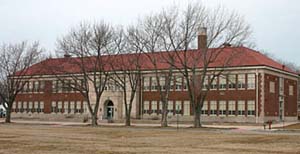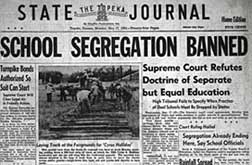May 2004 Feature
The Legacy of Brown v. Board of Education of Topeka

The Monroe Elementary School, one of the all-black schools in Topeka, KS, is now a National Historic Site. (National Park Service)
What do the following have in common? Laws preventing discrimination based on age, sex, disability, or religion; the Americans with Disabilities Act; Title IX; affirmative action; and the rectification of a major foreign policy dilemma when the United States, at least on paper, finally moved to assure the world that it was indeed a country where "all men are created equal." If you answered Brown v. Board of Education, you are correct.
While most Americans know the Brown case ruled that segregated schools were inherently unequal, the legacy of the case goes far beyond that, for it provided the basis for assuring equal treatment in many other venues and in our personal lives. There are many myths about Brown, and the history of how the case reached the Supreme Court is very long and complicated. The various web sites listed here provide access to sources that can help you understand this case.
As early as 1950, the New York office of the NAACP, under the leadership of Charles Hamilton Houston and Thurgood Marshall, was working in several states to strike down the 1896 Plessy v. Ferguson ruling that "separate but equal" school facilities were constitutional. When five cases reached the Supreme Court from Delaware, South Carolina, Virginia, Kansas, and the District of Columbia, they were combined by the Court into one case: Oliver L. Brown et. al. v. The Board of Education of Topeka (KS) et. al. Overall, there were about 200 plaintiffs. In the Topeka case alone, 13 parents were plaintiffs representing 20 children. There are many who believe that the reason for using the Brown name was that he was the only male plaintiff in the Topeka case. It was, after all, the 1950s.

Detail of the first page of the landmark Supreme Court decision in Brown v. Board of Education of Topeka. (Records of the Supreme Court of the United States, RG 267) [full image]
All cases reached the Court on appeals after having failed to overturn Plessy. Arguments began in December 1952. The Court asked the plaintiffs to reargue the case to address issues beyond equal facilities. Those arguments began in December 1953.
Two of the cases had major differences from the others. A dissenting opinion in the South Carolina Briggs case stated that segregation was "inequality," and in Topeka, the judges added a statement to the decision that segregation was detrimental to colored children. Topeka was also different in that the separated school facilities for black and white children were similar, raising the issue that segregation of itself was harmful to the children, regardless of the "equal" facilities. Topeka's high schools were integrated in the classroom but not in social or athletic programs. The elementary schools were, by state law, segregated in towns with populations greater than 15,000.
The primary question, oversimplified, concerned the intent of Congress when the 14th amendment was passed in 1868 and what constituted equal protection under that law. On May 17, 1954, Chief Justice Earl Warren answered that question, writing for the Court: "Does segregation of children in the public schools solely on the basis of race, even though the physical facilities and other 'tangible' factors may be equal, deprive the minority group of equal educational opportunities? We believe it does." It was a unanimous decision.

The Topeka State Journal reported the historic May 17, 1954, decision that segregation in public schools must end. (Records of District Courts of the United States, RG 21, NARA—Central Plains Region [Kansas City])
The commemoration of the 50th anniversary of Brown began in 1988, when Cheryl Brown Henderson, daughter of plaintiff Rev. Oliver Brown, who represented her sister, Linda, was asked by a friend what was being done to commemorate the decision. "Not much," she replied. Spurred on by this question, Cheryl organized the Brown Foundation for Educational Equality, Excellence and Research. When one of the segregated elementary schools in Topeka became available for purchase in 1990, she and other supporters approached the Kansas congressional delegation to encourage the National Park Service to consider making Monroe School a national park. On October 26, 2003, President George W. Bush signed legislation establishing the school as a National Historic Site. The site will be dedicated on May 17, 2004.
The Brown Foundation also sought national recognition for the commemoration, and on September 18, 2001, Congress passed and the President signed the law establishing the Brown v. Board of Education 50th Anniversary Commission, operated through the U.S. Department of Education, to "plan and coordinate educational activities . . . and to encourage, plan, develop and coordinate observances."
The National Archives and Records Administration quickly realized that, because NARA holds the Federal records pertaining to the five cases that constitute the Brown case and other Federal civil rights cases, it should take a leadership role in making those sources available through its web site and programs. The accompanying list can get you started in learning more about Brown and its legacy.
Dan Holt
Director, Eisenhower Presidential Library and Museum
Member, Brown v. Board Commemoration Commission
Author's note: I wish to thank Cheryl Brown Henderson for her assistance with this article.
Sources on the Web- The Brown Foundation, Topeka, KS.
- National Archives and Records Administration, Federal Records that Pertain to Brown v. Board of Education, Topeka, KS, Reference Information Paper No. 112.
Free copies are also available from the Research Support Branch (NWCC1), 700 Pennsylvania Avenue, NW, Washington, DC 20408-0001; telephone: 202-501-5235 or (toll free) 866-325-7208; fax: 202-501-7170. - Dwight D. Eisenhower Library
- NARA's Digital Classroom
- Howard University Law School
- National Education Association
- NAACP site with Brown links
- NAACP Legal Defense Fund
- U.S. Department of Education
PDF files require the free Adobe Reader.
More information on Adobe Acrobat PDF files is available on our Accessibility page.
